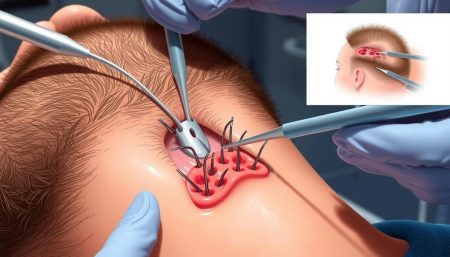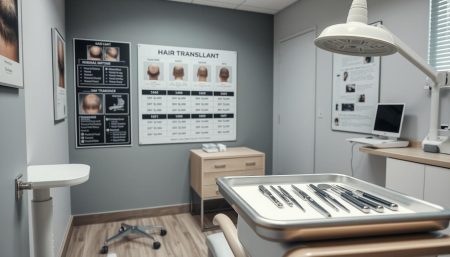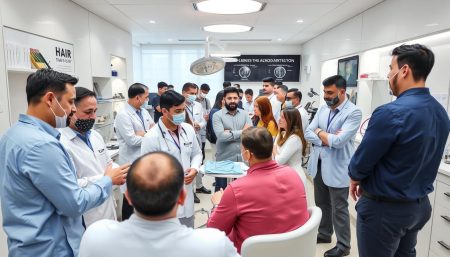The United Kingdom is a leader in hair transplant surgery. It offers top-notch solutions for those wanting to regain their hair. With renowned specialists and modern facilities, the UK is a top choice for hair transplant procedures.
Hair transplant surgery in the UK has come a long way. It now uses advanced techniques for natural-looking results. From London’s Harley Street to Manchester and Glasgow, patients find many hair restoration options.
This guide covers the UK’s hair transplant scene. We’ll look at new procedures, top clinics, costs, and more. Our aim is to help you understand your hair restoration options better.
Understanding Hair Transplant Procedures in the UK
Hair transplant procedures in the United Kingdom have made big strides. They offer new ways to tackle hair loss. The UK’s medical scene is at the forefront, with top-notch techniques and strict rules. This means patients get the best care possible.
Modern Transplant Techniques and Innovations
The UK has seen huge leaps in hair restoration. Follicular Unit Extraction (FUE) and Direct Hair Implantation (DHI) lead the way. These methods are gentle and give natural-looking results.

UK Medical Standards and Regulations
Hair transplant clinics in the UK follow strict rules from the Care Quality Commission. This ensures they keep high standards of cleanliness, safety, and ethics. Patients can be sure their treatment will be in a safe place.
Patient Assessment and Consultation Process
Before a hair transplant, patients in the UK get a detailed check-up. This includes:
- Evaluating hair loss pattern and how bad it is
- Talking about medical history and what they hope for
- Looking at how much donor hair they have
- Talking about the best treatment options
| Consultation Step | Purpose |
|---|---|
| Initial Assessment | Determine hair loss extent and type |
| Medical Review | Identify any contraindications |
| Treatment Planning | Outline procedure and expected outcomes |
| Cost Discussion | Provide transparent pricing information |
This detailed process makes sure each patient gets a treatment plan made just for them. It boosts the chances of a successful hair transplant in the UK.
The Evolution of Hair Transplant Surgery UK
Hair transplant surgery in the UK has seen big changes over the years. It started in the 1950s with simple methods that didn’t always look natural. As doctors learned more, the ways to restore hair got better.
The 1990s were a big turning point. Doctors began using a new method called follicular unit transplantation. This allowed them to move single hair follicles, making the results look more natural.
The 2000s brought even more changes. Follicular Unit Extraction (FUE) became popular in the UK. It’s a gentle method that causes less scarring and heals faster, making it a favourite among patients.
- 1950s: Introduction of punch graft technique
- 1990s: Shift to follicular unit transplantation
- 2000s: Advent of Follicular Unit Extraction (FUE)
Now, UK hair transplant clinics are leading in new technology. They use robots and stem cell treatments to improve hair restoration. These advances are making hair transplants more successful and natural-looking in the UK.
Top-Rated Hair Transplant Clinics London: A Guide
London is a leader in hair transplant services in the UK. It has top-notch treatments and new solutions. The famous Harley Street and nearby areas have the best hair transplant clinics in London.
Harley Street Specialists and Services
Harley Street is known for medical excellence. Its hair transplant specialists are among the best. They offer services like Follicular Unit Extraction (FUE) and Direct Hair Implantation (DHI).
Patients get custom treatment plans and the latest techniques. This makes their hair transplant experience better.

Leading Central London Facilities
Central London has modern facilities with the latest hair restoration tech. These clinics focus on patient comfort and great results. They use advanced imaging and precise tools for natural-looking hair.
| Clinic | Speciality | Treatment Options |
|---|---|---|
| Harley Street Hair Clinic | FUE Transplants | FUE, Scalp Micropigmentation |
| The Private Clinic | Minimally Invasive Procedures | FUE, Eyebrow Transplants |
| Wimpole Clinic | Comprehensive Hair Loss Solutions | FUT, FUE, Non-Surgical Treatments |
Patient Success Stories and Reviews
Many patients have seen big changes after hair transplants. They feel more confident and happy with their looks. Reviews praise the clinic staff and the natural results.
“My hair transplant in London was life-changing. The care and expertise I received were exceptional, and the results exceeded my expectations.”
Looking for hair transplant clinics in London? Do your research and talk to them first. London’s top clinics offer great care from start to finish. They help you get the best results for your hair restoration in the UK.
Hair Transplant United Kingdom: Treatment Options and Solutions
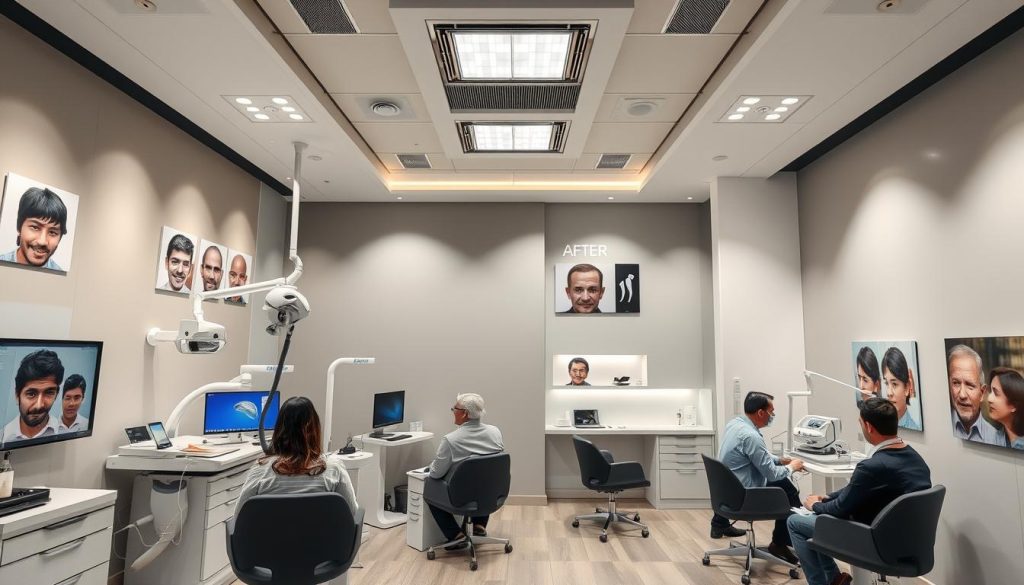
The United Kingdom has many hair transplant solutions for those with hair loss. You can find treatments from old methods to new ones. Each treatment is designed to meet your specific needs.
Follicular Unit Extraction (FUE) is a favourite in UK clinics. It’s a gentle way to take out hair follicles and put them in thin spots. FUE causes little scarring and you can get back to normal quickly.
Follicular Unit Transplantation (FUT) is another choice. It takes a strip of scalp, cuts it into units, and transplants them. It might leave a line scar, but it’s good for those needing many grafts.
UK clinics also offer custom plans. They mix different treatments like:
- Platelet-rich plasma therapy
- Scalp micropigmentation
- Low-level laser therapy
- Medication-based treatments
New hair restoration tech is coming to the UK. Things like robotic systems and stem cell therapy are being tested. They aim to make treatments better.
If you’re thinking about a hair transplant in the UK, see a specialist first. They can check what you need and suggest the best treatment. This way, you get results that look natural and last long.
FUE Hair Transplant UK: Advanced Surgical Methods
FUE hair transplant UK procedures have changed hair restoration surgery. This modern method is less invasive and gives natural-looking results. Let’s look at the advanced techniques used in FUE transplants in the UK.
Technology and Equipment Used
Modern FUE hair transplant surgery UK clinics use the latest technology. They have advanced microscopes and special tools for extracting hair follicles with little scarring. Some clinics even use robots to make the process more precise.
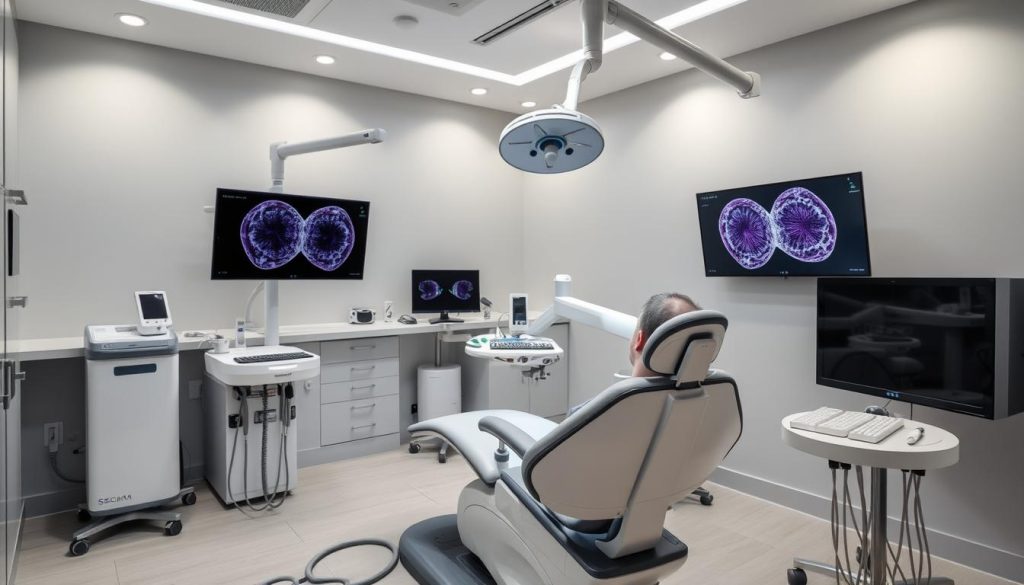
Recovery and Aftercare Protocols
Recovery from FUE hair transplant UK procedures is quick. Most people can go back to work in a few days. Aftercare includes gentle scalp cleaning, avoiding hard work, and protecting the transplanted area from the sun. Clinics give detailed instructions for the best healing and growth.
Expected Results and Timeframes
Results from FUE hair transplant UK treatments show up over time. You might see growth in 3-4 months, with big changes in 6-9 months. Full results usually take 12-18 months. Patients get permanent, natural-looking hair that matches their existing hair.
| Timeline | Expected Progress |
|---|---|
| 3-4 months | Initial growth visible |
| 6-9 months | Significant improvements |
| 12-18 months | Full results achieved |
Hair Transplant Cost UK: Investment and Financial Planning
Understanding the cost of a hair transplant in the UK is key for those thinking about it. The price varies based on how much hair you’ve lost and the technique used.
A hair transplant in the UK can cost between £3,000 and £15,000. This range shows the variety of treatments and the skill of surgeons. Here’s a look at the costs for different procedures:
| Procedure | Average Cost | Number of Grafts |
|---|---|---|
| FUE (Follicular Unit Extraction) | £5,000 – £12,000 | 1,000 – 3,000 |
| FUT (Follicular Unit Transplantation) | £4,000 – £10,000 | 1,000 – 3,000 |
| DHI (Direct Hair Implantation) | £6,000 – £15,000 | 1,000 – 3,000 |
The clinic and surgeon’s reputation greatly affects the cost. London’s Harley Street specialists often charge more. Many clinics offer financing, with monthly payments from £100 to £500.
When planning for a hair transplant in the UK, remember extra costs. This includes post-care products and follow-up visits. These can add £200 to £500 but are vital for the best results.
“Investing in a hair transplant is not just about the immediate cost. It’s an investment in your confidence and long-term well-being,” says Dr Sarah Thompson, a leading UK hair restoration specialist.
While cost is important, it shouldn’t be the only thing you think about. Look for quality, expertise, and proven results when choosing a provider. This is a life-changing procedure.
Premier Hair Transplant Manchester Facilities
Manchester is a top spot for hair transplants in Northern England. It has world-class facilities and skilled experts. This makes it a great choice for those looking for hair transplant services outside London.
Northern England’s Leading Specialists
Manchester’s hair restoration experts are known for their skill and new methods. They use advanced techniques to give natural-looking results. This draws patients from all over the UK and further afield.
The city’s clinics have the latest technology for top care. Many Manchester practitioners have a lot of experience with complex hair transplant procedures. They can help with different hair types and needs.
Local Treatment Options
Manchester has many hair transplant options to meet different needs. You can choose from traditional FUT to modern robotic-assisted methods. This lets patients pick the best option for their goals.
| Treatment | Description | Recovery Time |
|---|---|---|
| FUE (Follicular Unit Extraction) | Minimally invasive technique, individual follicles extracted | 1-2 weeks |
| DHI (Direct Hair Implantation) | Precise implantation using specialised tools | 3-4 days |
| Scalp Micropigmentation | Non-surgical option, creates illusion of fuller hair | Immediate |
Manchester is a key player in hair transplants thanks to its top facilities and wide range of treatments. Patients get personal care, the latest techniques, and the best from Northern England’s hair restoration experts.
Hair Loss Treatment UK: Complete Solutions
The UK has many hair loss treatment options, not just surgery. People looking for hair restoration in the UK can choose from medical treatments and non-invasive methods. Many clinics use a mix of treatments for the best results.
Medical treatments are key in managing hair loss. In the UK, doctors often prescribe Minoxidil and finasteride. These drugs help slow down hair loss and encourage new growth, part of a full hair loss treatment plan.
Non-invasive methods are also popular. Scalp micropigmentation creates the look of thicker hair. Laser therapy, another non-surgical option, helps stimulate hair follicles for growth.
| Treatment Type | Description | Duration |
|---|---|---|
| Minoxidil | Topical solution to stimulate hair growth | Ongoing |
| Finasteride | Oral medication to reduce hair loss | Continuous use |
| Scalp Micropigmentation | Tattoo-like procedure for fuller appearance | 2-3 sessions |
| Laser Therapy | Low-level light treatment for hair stimulation | Weekly sessions |
UK hair restoration experts often suggest a mix of treatments. This tailored approach helps patients get the best hair loss treatment. It meets their specific needs and goals.
Hair Restoration UK: Non-Surgical Alternatives
In the UK, there are many non-surgical ways to treat hair loss. These options are effective and don’t require surgery.
Medical Treatments Available
There are several medical treatments for hair loss in the UK. Topical solutions like minoxidil help hair grow when applied to the scalp. Oral medicines, like finasteride, block hormones that cause hair loss.
Injectable treatments, like platelet-rich plasma (PRP), use your body’s growth factors to help hair grow back.
| Treatment | Application | Effectiveness |
|---|---|---|
| Minoxidil | Topical | Moderate |
| Finasteride | Oral | High |
| PRP | Injectable | Variable |
Preventative Care Options
Preventative care is important for hair loss treatment in the UK. Eating a healthy diet full of proteins, vitamins, and minerals helps your hair. Regular scalp massages can also help by improving blood flow.
Managing stress and avoiding harsh hair treatments can also help keep your hair healthy.
- Balanced diet with essential nutrients
- Gentle hair care practices
- Stress reduction techniques
- Regular scalp massages
Starting treatment early is vital for hair restoration in the UK. Using medical treatments and preventative care together is the best way to keep your hair healthy and slow hair loss.
Choosing a Hair Transplant Birmingham Provider
Birmingham, a vibrant city in the United Kingdom, offers many options for hair transplant solutions. When picking a hair transplant Birmingham provider, it’s key to think about a few things. This ensures the best results for you.
Qualifications and experience are very important when choosing a hair transplant specialist. Look for surgeons who are part of recognised medical groups. They should also have a good history in hair restoration.
Before-and-after photos and patient reviews can give you a good idea of a clinic’s skill. These can help you see if the clinic is right for you.
The best hair transplant places in Birmingham have the latest technology and use the latest methods. They offer both FUE (Follicular Unit Extraction) and FUT (Follicular Unit Transplantation) methods. This means they can meet different patient needs.
| Factor | Importance |
|---|---|
| Surgeon’s qualifications | High |
| Clinic’s reputation | High |
| Treatment options | Medium |
| Cost | Medium |
| Location | Low |
When looking at hair transplant options in the United Kingdom, Birmingham clinics have a lot to offer. Some focus on less invasive methods. Others provide full hair restoration packages, including care after the transplant.
By looking at these factors, you can make a smart choice. You can find a hair transplant Birmingham provider that meets your needs and expectations.
Hair Transplant Glasgow: Scottish Medical Excellence
Glasgow is a top spot for hair transplant services in Scotland. It offers excellent care for those looking to restore their hair. The city’s clinics mix Scottish warmth with the latest medical tech, making it a key place for hair transplant services in the UK.
Leading Scottish Practitioners
Glasgow is home to many skilled hair transplant specialists. They have years of experience and keep learning. Many of these experts are part of top medical groups, keeping up with the latest in hair restoration.
- Extensive experience in FUE and FUT procedures
- Regular participation in international hair restoration conferences
- Commitment to personalised patient care
Regional Treatment Specialities
Hair transplant clinics in Glasgow have unique skills. They are experts in treating different hair types, including Scotland’s red hair. This means they can give results that look natural for local people.
They also do great work with scalp micropigmentation and hair transplants. This combo makes hair look fuller and patients happier.
| Treatment | Speciality |
|---|---|
| FUE Transplant | Red hair specialisation |
| Scalp Micropigmentation | Combined with transplants |
| Beard Transplants | Scottish facial hair patterns |
Glasgow is known for its medical skill and custom treatments. It’s a top choice for hair transplant services in the UK.
Post-Operative Care and Recovery Guidelines
After getting a hair transplant in the UK, it’s key to follow aftercare tips for the best results. The healing process needs patience and sticking to certain rules.
Right after surgery, you’ll need to manage any pain and keep the new grafts safe. Most clinics give you clear instructions, like:
- Sleeping with your head up for a few nights
- Avoiding direct water pressure on your scalp when washing
- Not doing too much for 7-10 days
- Taking your medicines as told
The recovery time for hair transplant patients in the UK usually lasts a few months. Here’s what you can expect:
| Time Frame | Expected Progress |
|---|---|
| 1-2 weeks | Initial healing, scabs form and fall off |
| 2-4 weeks | Transplanted hair sheds, temporary thinning occurs |
| 3-4 months | New hair growth begins |
| 6-12 months | Significant improvement in hair density |
| 12-18 months | Final results become apparent |
Looking after your hair long-term is vital to keep the transplant results. Use gentle hair products, protect your scalp from the sun, and live a healthy lifestyle to help your hair grow.
Understanding Hair Transplant Success Rates
Hair transplant success rates in the United Kingdom have greatly improved. New techniques in hair restoration UK have led to better, longer-lasting results. This is good news for those looking to tackle hair loss.
Statistical Analysis and Outcomes
Recent studies on hair transplant United Kingdom procedures show promising results. A survey of 1,000 patients found that 85% were happy with their results a year after surgery. Success depends on many things, like how well the patient fits the procedure, the surgeon’s skill, and the method used.
| Factor | Impact on Success Rate |
|---|---|
| Patient Age | Younger patients (25-45) show 90% success rate |
| Hair Loss Pattern | Crown area transplants have 80% success rate |
| Surgeon Experience | Surgeons with 10+ years experience achieve 95% success rate |
Long-term Results Documentation
Long-term success of hair restoration UK procedures is closely monitored. Clinics use advanced imaging to track hair growth. Patients are photographed at 3, 6, and 12 months post-surgery, with yearly check-ups after that.
It’s important for patients to have realistic expectations. A successful hair transplant in the United Kingdom means natural-looking results, more hair density, and better self-confidence. Many things can affect the outcome, like how well the patient heals, follows post-operative care, and their lifestyle.
Patient Journey: From Consultation to Recovery
Starting a hair transplant journey in the United Kingdom has several stages. It begins with a consultation where patients talk about their goals with a specialist. The doctor then checks the patient’s hair loss and decides the best treatment.
Next, patients have pre-operative checks to make sure they’re ready for surgery. This might include blood tests and scalp checks. On the surgery day, they get detailed instructions and prepare for the procedure.
The surgery can take several hours, depending on the treatment needed. Patients are awake but feel comfortable. After, they get detailed aftercare advice to help with healing and results.
| Stage | Duration | Key Activities |
|---|---|---|
| Consultation | 1-2 hours | Assessment, planning, expectations discussion |
| Pre-operative | 1-2 weeks | Medical tests, lifestyle adjustments |
| Surgery | 4-8 hours | Hair extraction, transplantation |
| Recovery | 2-3 weeks | Wound healing, initial hair growth |
| Final Results | 12-18 months | Full hair growth, styling options |
The recovery period is key for the best hair transplant results. Patients must avoid hard work and protect their scalp from the sun. Regular check-ups help doctors track progress and solve any issues.
Hair transplant clinics in the UK stress the need for patience during recovery. While some results may show in a few months, the full effects take 12 to 18 months.
Latest Innovations in UK Hair Restoration
The world of hair restoration in the UK is changing fast. New technologies are making a big difference in hair transplants. British experts are leading these changes, making hair restoration better than ever.
Emerging Technologies
Robotic-assisted hair transplants are becoming popular in the UK. They use artificial intelligence to pick and move hair follicles. This makes the process more precise and reduces damage to the scalp.
Stem cell therapy is another exciting area. It uses a patient’s own stem cells to grow new hair follicles. This could help people with severe hair loss.
Research and Development
The UK is investing a lot in hair transplant research. Scientists are looking into new growth factors and bioengineered hair follicles. They want to make hair transplants even more effective.
| Innovation | Potential Impact | Development Stage |
|---|---|---|
| Robotic FUE | Increased accuracy, reduced scarring | In use at select UK clinics |
| Stem Cell Therapy | Hair regeneration without transplantation | Clinical trials |
| Bioengineered Follicles | Unlimited hair supply for transplants | Early research phase |
These new technologies show the UK’s dedication to improving hair restoration. They promise better and less painful ways to treat hair loss.
Choosing the Right UK Hair Transplant Specialist
Finding the right hair transplant specialist in the UK is important. You need to look at their qualifications, experience, and technique skills. A good specialist should have the right certifications and a history of successful hair restorations.
How well you get along with your doctor matters a lot. Pay attention during your consultation. A specialist who listens and explains things clearly is best. They should also create a plan that fits your needs for the best results.
Doing your homework is essential. Check out patient reviews, look at before-and-after photos, and verify the surgeon’s credentials. Top clinics share their work and patient feedback. This helps you understand their skills. By carefully choosing, you boost your chances of a great hair restoration in the UK.
FAQ
Q: What is the average cost of a hair transplant in the UK?
A: Hair transplant costs in the UK vary. They depend on hair loss extent, technique, and clinic reputation. Prices range from £3,000 to £15,000. Remember, higher cost doesn’t always mean better quality. Do your research well.
Q: How long does a typical hair transplant procedure take in the UK?
A: Hair transplant times in the UK vary. They can last from 4 to 8 hours. This depends on how much hair is transplanted and the technique used. FUE procedures usually take longer because each hair follicle is extracted individually.
Q: What is the recovery time after a hair transplant in the UK?
A: Recovery times differ, but most can go back to work in 1-2 weeks. Yet, full results take 12-18 months. This is because the transplanted hair grows over time.
Q: Are hair transplants in the UK permanent?
A: Yes, hair transplants in the UK are usually permanent. The hair comes from areas not prone to balding, like the back of the head. But, hair loss can continue in other areas not transplanted.
Q: What are the main hair transplant techniques used in the UK?
A: The UK uses FUE and FUT techniques. FUE extracts individual follicles, while FUT takes a strip of skin with follicles. FUE is more popular for its less invasive nature and minimal scarring.
Q: Are there any non-surgical alternatives to hair transplants available in the UK?
A: Yes, the UK offers non-surgical hair loss treatments. These include minoxidil, finasteride, PRP therapy, low-level laser therapy, and scalp micropigmentation. These can be used alone or with surgery for best results.
Q: How do I choose the best hair transplant clinic in the UK?
A: Choose a clinic based on the surgeon’s qualifications, reputation, patient reviews, and before-and-after photos. A detailed consultation is also key to discuss your needs and expectations.
Q: What qualifications should I look for in a UK hair transplant surgeon?
A: Look for GMC registration and BAHRS membership. Additional qualifications in plastic surgery or dermatology are also beneficial.
Q: Are there any risks associated with hair transplants in the UK?
A: Hair transplants in the UK are safe with qualified professionals. Risks include infection, bleeding, scarring, unnatural hair growth, and rare rejection. Discuss these risks with your surgeon.
Q: Can women undergo hair transplants in the UK?
A: Yes, women can get hair transplants in the UK. But, female hair loss patterns differ from men’s. A specialist assessment is needed to see if a transplant is right for you.













